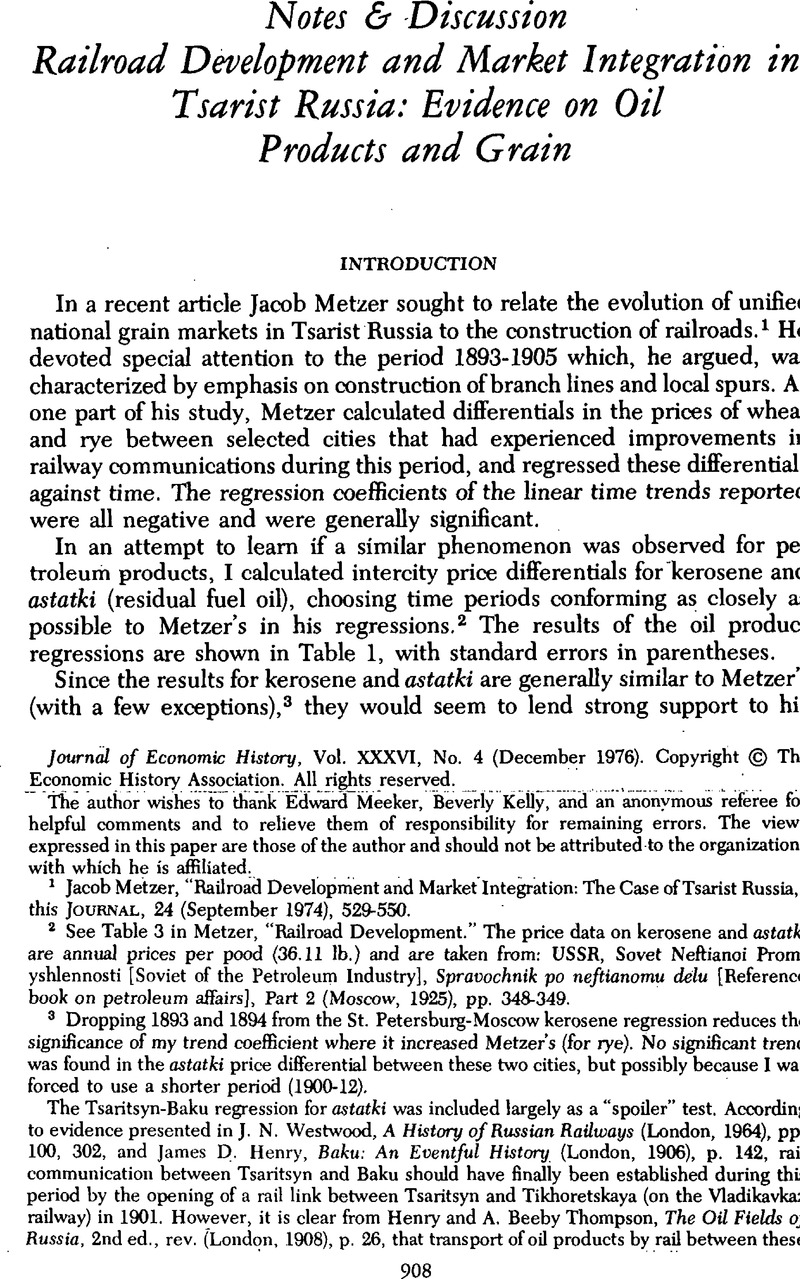Article contents
Railroad Development and Market Integration in Tsarist Russia: Evidence on Oil Products and Grain
Published online by Cambridge University Press: 11 May 2010
Abstract

- Type
- Notes and Discussion
- Information
- Copyright
- Copyright © The Economic History Association 1976
References
1 Metzer, Jacob, “Railroad Development and Market Integration: The Case of Tsarist Russia,” this Journal, 24 (09 1974), 529–550Google Scholar.
2 See Table 3 in Metzer, “Railroad Development.” The price data on kerosene and astatki are annual prices per pood (36.11 lb.) and are taken from: USSR, Sovet Neftianoi Promyshlennosti [Soviet of the Petroleum Industry], Spravochnik po neftianomu delu [Reference book on petroleum affairs], Part 2 (Moscow, 1925), pp. 348–349Google Scholar.
3 Dropping 1893 and 1894 from the St. Petersburg-Moscow kerosene regression reduces the significance of my trend coefficient where it increased Metzer's (for rye). No significant trend was found in the astatki price differential between these two cities, but possibly because I was forced to use a shorter period (1900-12).
The Tsaritsyn-Baku regression for astatki was included largely as a “spoiler” test. According to evidence presented in Westwood, J. N., A History of Russian Railways (London, 1964), pp. 100, 302Google Scholar, and Henry, James D., Baku: An Eventful History (London, 1906), p. 142Google Scholar, rail communication between Tsaritsyn and Baku should have finally been established during this period by the opening of a rail link between Tsaritsyn and Tikhoretskaya (on the Vladikavkaz railway) in 1901. However, it is clear from Henry, and Thompson, A. Beeby, The Oil Fields of Russia, 2nd ed., rev. (London, 1908), p. 26Google Scholar, that transport of oil products by rail between these two cities must have been much more expensive than by the traditional water route along the Caspian Sea and Volga River. Since petroleum products continued to move from Baku to Tsaritsyn almost exclusively by water, a negative coefficient in the Tsaritsyn-Baku regression for astatki would cast doubt on the Metzer railroad hypothesis and suggest that some non-railroad phenomenon was influencing intercity price differentials (e.g., innovations in storage or credit). A significant positive trend was observed in the differential between these two cities, however, so the spoiler test did not contradict the Metzer thesis.
4 Kelly, William J. and Kano, Tsuneo, “Crude Oil Production in the Russian Empire: 1818-1919,” Journal of European Economic History (forthcoming), Table 4Google Scholar.
5 See footnote 3.
6 , Westwood, A History, pp. 100, 168, 302–03Google Scholar.
7 Ibid., pp. 159, 130-35.
8 Ibid., pp. 159, 137. The mileage increase was estimated from figures on pp. 134, 140-41, and 159.
9 See , Metzer, “Railroad Development,” pp. 533–45Google Scholar.
10 One verst equals 0.6629 miles.
11 Rubinow, I. M., Russia's Wheat Trade, U.S.D.A. Bulletin 65 (Washington, D.C., 1908), p. 143Google Scholar.
12 Ibid., pp. 39-49.
13 Further exceptions were made to appease the disappointed producers in Siberia. A new Irailroad was built from Perm to Kotlas on the Northern Dvina River and special railroad rates Iwere provided on grain exported via this northern route. As a result, wheat exports suddenly began to move through Archangel on the White Sea. , Rubinow, Russia's Wheat Trade, pp. 45–47Google Scholar; Lyashchenko, Peter I., History of the National Economy of Russia (New York, 1949), pp. 513–514Google Scholar; and Laue, Theodore H. Von, Sergei Witte and the Industrialization of Russia (New York, 1974), pp. 90–91Google Scholar.
14 , Rubinow, Russia's Wheat Trade, pp. 48–49Google Scholar.
15 , Westwood, A History, pp. 146–147Google Scholar.
16 , Thompson, The Oil Fields of Russia, p. 31Google Scholar.
17 , Henry, Baku, p. 241Google Scholar.
18 Laue, Von, Sergei Witte, pp. 90–91Google Scholar.
19 , Henry, Baku, p. 241Google Scholar.
20 Kennard, Howard P., ed., The Russian Year-Book for 1913 (London, 1913), p. 214Google Scholar.
21 , Henry, Baku, pp. 242–243Google Scholar.
22 Two points should be noted. First, levels of costs and rates could diverge substantially while at the same time movements in rates and costs were positively correlated. Second, Metzer and I implicitly assume that freight rates and transportation costs were in equilibrium at the beginning of the period in question. If instead a disequilibrium situation had existed, then divergences in levels and in the directions of movements of costs and rates might have been a reflection of economic and political adjustments leading toward a new equilibrium. The types of case studies recommended in Part III should improve our ability to judge whether an assumption of initial equilibrium is more appropriate than an assumption of disequilibrium.
- 3
- Cited by




